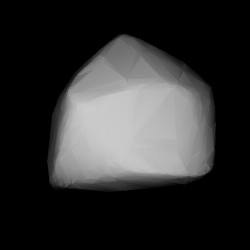Astronomy:171 Ophelia
 3D convex shape model of 171 Ophelia | |
| Discovery | |
|---|---|
| Discovered by | A. Borrelly |
| Discovery date | 13 January 1877 |
| Designations | |
| (171) Ophelia | |
| Pronunciation | /oʊˈfiːliə/[1] |
| A877 AB | |
| Minor planet category | Main belt (Themis) |
| Adjectives | Ophelian /ɒˈfiːliən/[2] |
| Orbital characteristics[3] | |
| Epoch 31 July 2016 (JD 2457600.5) | |
| Uncertainty parameter 0 | |
| Observation arc | 122.15 yr (44615 d) |
| |{{{apsis}}}|helion}} | 3.5476 astronomical unit|AU (530.71 Gm) |
| |{{{apsis}}}|helion}} | 2.7175 AU (406.53 Gm) |
| 3.1326 AU (468.63 Gm) | |
| Eccentricity | 0.13249 |
| Orbital period | 5.54 yr (2025.1 d) |
| Mean anomaly | 11.164° |
| Mean motion | 0° 10m 39.972s / day |
| Inclination | 2.5461° |
| Longitude of ascending node | 100.52° |
| 56.849° | |
| Physical characteristics | |
| Mean diameter | 130.808±1.483 km[4] |
| Rotation period | 6.66535 h (0.277723 d) |
| Geometric albedo | 0.0615±0.004 |
| C | |
| Absolute magnitude (H) | 8.31 |
Ophelia (minor planet designation: 171 Ophelia) is a large, dark Themistian asteroid[5] that was discovered by French astronomer Alphonse Borrelly on 13 January 1877, and named after Ophelia in Shakespeare's Hamlet.[6]
This asteroid is a member of the Themis family of asteroids that share similar orbital elements.[7] It probably has a primitive composition, similar to that of the carbonaceous chondrite meteorites.
A 1979 study of the Algol-like light curve produced by this asteroid concluded that it was possible to model the brightness variation by assuming a binary system with a circular orbit, a period of 13.146 hours, and an inclination of 15° to the line of sight from the Earth.[8] Photometric observations of this asteroid at the Leura Observatory in Leura, Australia during 2006 gave a rotation period of 6.6666 ± 0.0002 hours and a brightness variation of 0.50 ± 0.02 in magnitude. This is in agreement with previous studies.[9]
Ophelia is also the name of a moon of Uranus.
References
- ↑ Benjamin Smith (1903) The Century Dictionary and Cyclopedia
- ↑ Ophelian (3rd ed.), Oxford University Press, September 2005, http://oed.com/search?searchType=dictionary&q=Ophelian (Subscription or UK public library membership required.)
- ↑ Yeomans, Donald K., "171 Ophelia", JPL Small-Body Database Browser (NASA Jet Propulsion Laboratory), https://ssd.jpl.nasa.gov/sbdb.cgi?sstr=171, retrieved 6 May 2016.
- ↑ Small-Body Database Lookup
- ↑ Florczak, M. et al. (February 1999). "A spectroscopic study of the THEMIS family". Astronomy and Astrophysics Supplement 134 (3): 463–471. doi:10.1051/aas:1999150. Bibcode: 1999A&AS..134..463F.
- ↑ Schmadel, Lutz (2003) (in en). Dictionary of Minor Planet Names. Springer Science & Business Media. pp. 30. ISBN 9783540002383. https://books.google.com/books?id=VoJ5nUyIzCsC&q=Ophelia. Retrieved 17 July 2019.
- ↑ Moore, Patrick; Rees, Robin, eds. (2011), Patrick Moore's Data Book of Astronomy (2nd ed.), Cambridge University Press, p. 165, ISBN 9781139495226, https://books.google.com/books?id=2FNfjWKBZx8C&pg=PA165.
- ↑ Wijesinghe, M. P.; Tedesco, E. F. (December 1979), "A test of plausibility of eclipsing binary asteroids", Icarus 40 (3): 383–393, doi:10.1016/0019-1035(79)90031-9, Bibcode: 1979Icar...40..383W.
- ↑ Oey, Julian (December 2006), "Lightcurves analysis of 10 asteroids from Leura Observatory", The Minor Planet Bulletin 33 (4): 96–99, Bibcode: 2006MPBu...33...96O.
External links
- 171 Ophelia at AstDyS-2, Asteroids—Dynamic Site
- 171 Ophelia at the JPL Small-Body Database
 |

